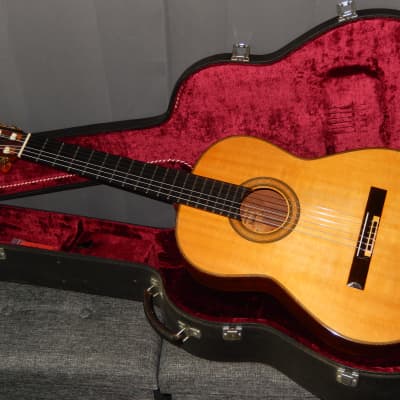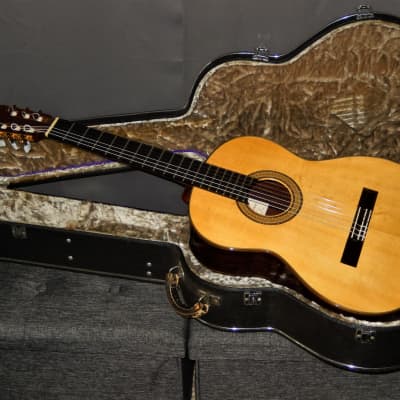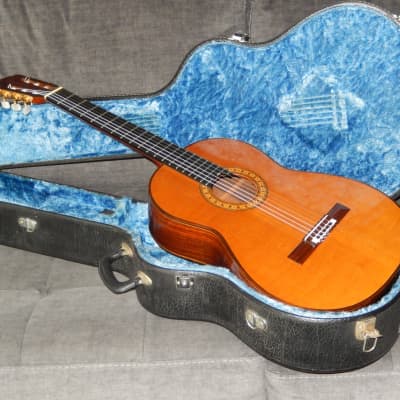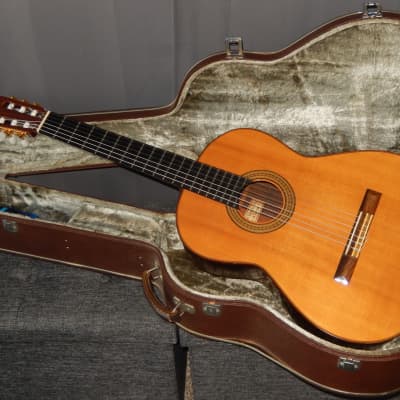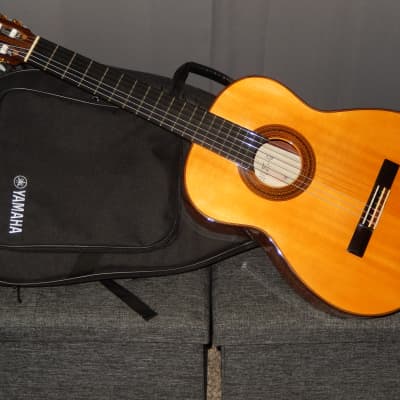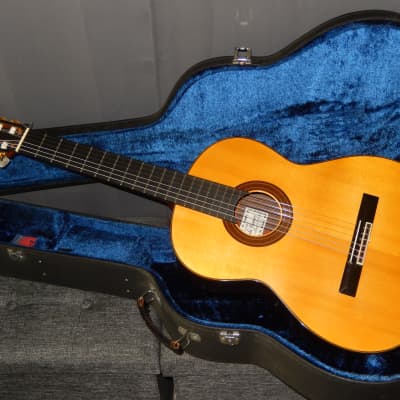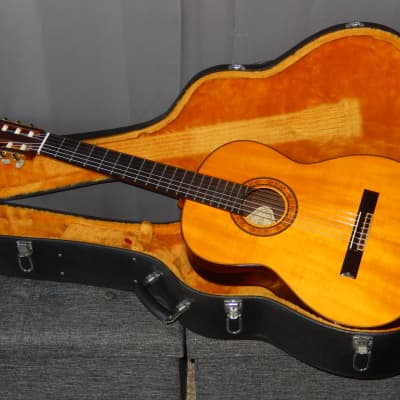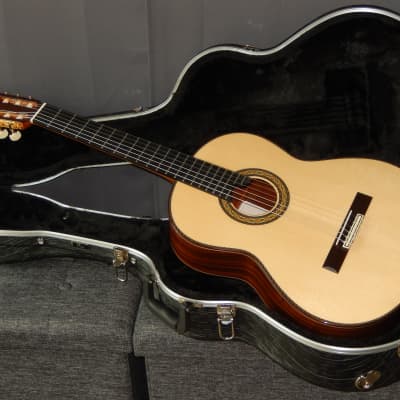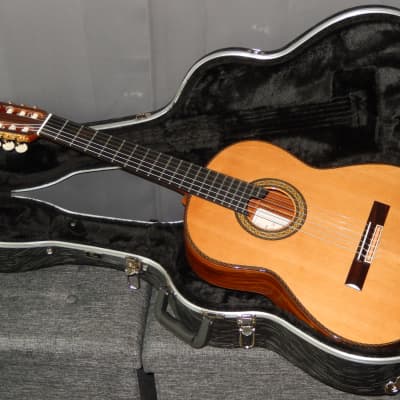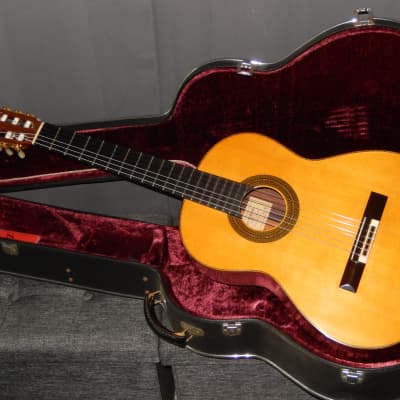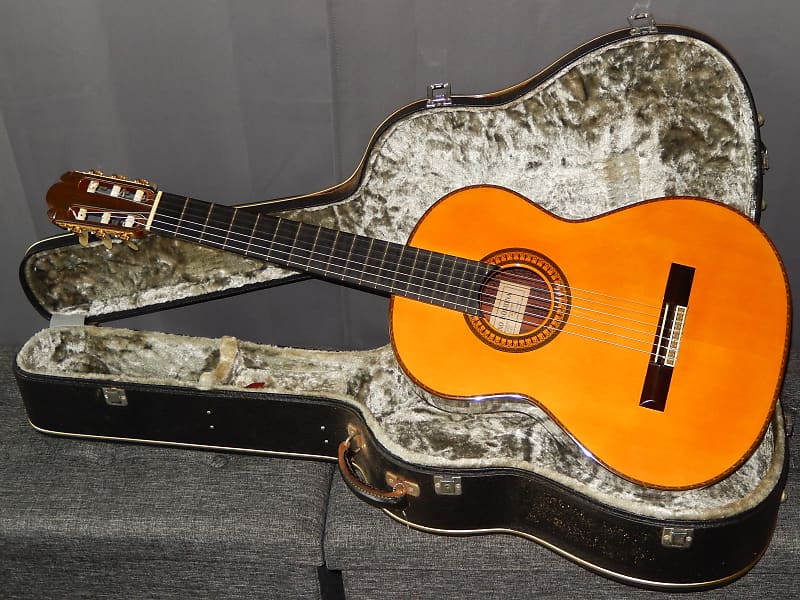

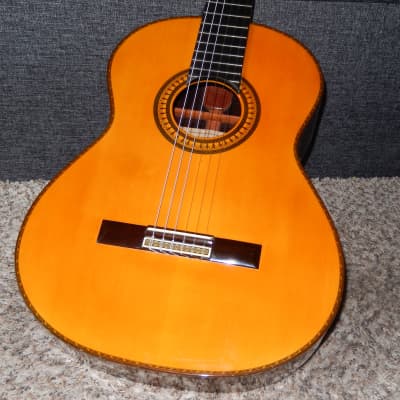
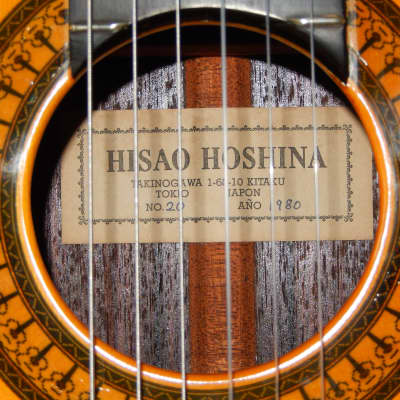
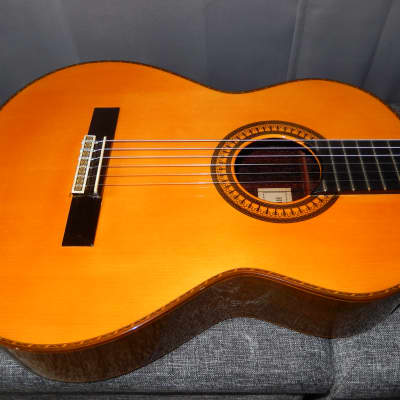
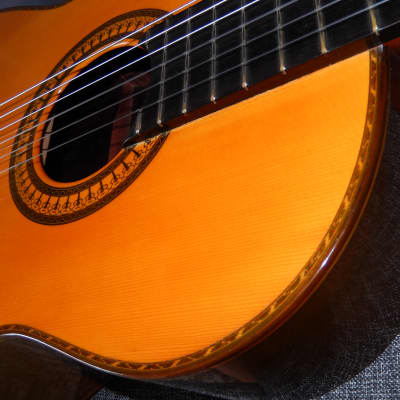
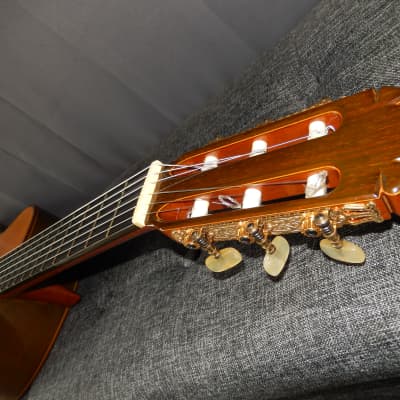
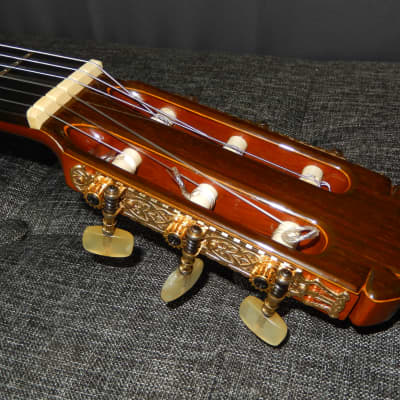
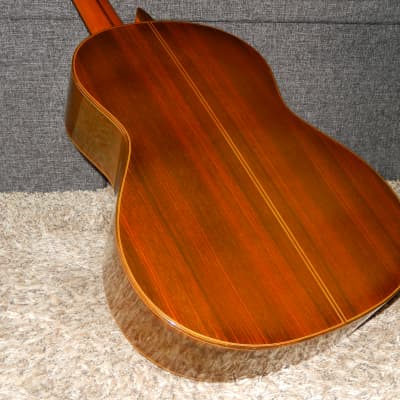
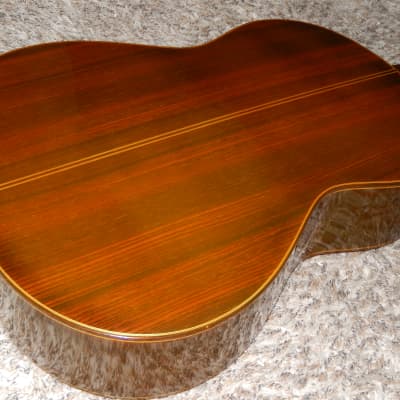
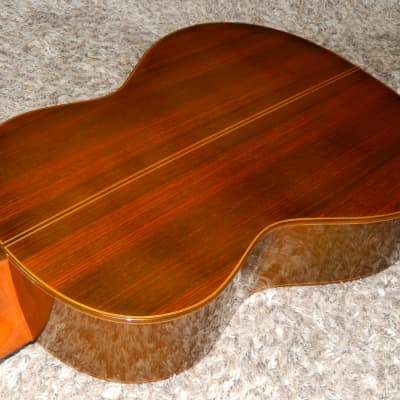
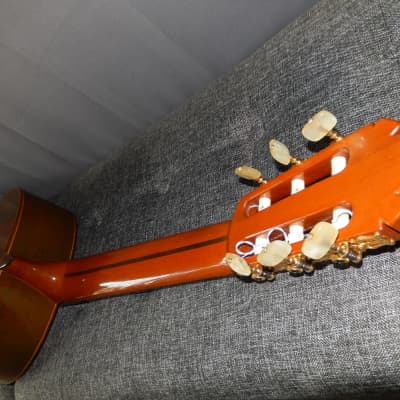
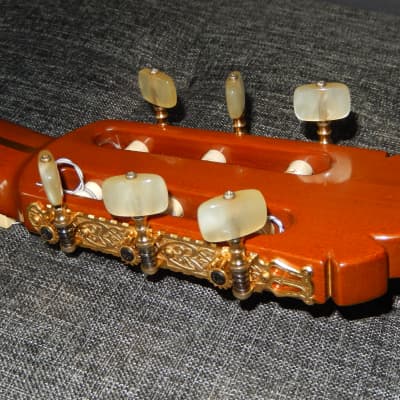
Hisao Hoshina Classical Grand Concert Guitar No. 20 1980
While searching internet you won’t find much information about this luthier. Because his guitars are truly very hard to find, logical conclusion is that he was working mostly by himself. My findings suggest that he started making guitars in early 1960s as apprentice at Mitsuru Tamura workshop. He established his own workshop in early 1970s and continued until late 2000s. Even though he has not earned any international fame, his guitars are very highly regarded in Japan.
His guitars are the best proof of how great luthier he really was. As it was true with many other less prominent Japanese luthiers, who had no strong ties with international importers, Hisao had to price his terrific instruments at much lower level if compared with similar grade guitars made by Japanese elite luthiers (Masaru Kohno, Sakazo & Toshihiko Nakade, Mitsuru and Hiroshi Tamura, Yamaha etc.).
Guitar you are looking at was priced 200 000 yen in 1978. If exactly the same grade guitar was made by more famous Japanese luthier it would be priced at least 300 000 yen. This guitar easily challenges Kohno N0 30 from the same year.
In 1980 great majority of 200 000 yen Japanese made classical guitars were made with solid figured Brazilian Rosewood b/s. Some were made solid straight grain BR. There have been some 200 000 yen models made with non-solid (figured or straight grain) Brazilian Rosewood (usually double backs and/or double sides).
For many makers 200 000 yen models were the top of the line, while some makers were selling their very top models for 150 000 yen (e.g. Ryoji Mastuoka No150, MH150, MR150, Kazuo Yairi YC150 or Takamine 15). Yamaha’s top models were GC30A, GC30B (priced 300 000 yen). Masaru Kohno’s top model was No50 and Sakazo Nakade’s No.5000 (priced 500 000 yen).
Less prominent luthiers had to accept far lower prices for their equally great instruments. In 1980 it was not very difficult to find in Japan a very high grade instrument made with solid figured BR b/s priced 150 000 yen (e.g. Takeo Koba No15, Hakusui Imai No15). However, in just few years prices of most of these guitars had gone up by 50% on average. By 1982 very few 200 000 yen models (Ryoji Matsuoka M200, Takamine 20 or Yamaha GC20) were still made with solid figured Brazilian Rosewood b/s. Kazuo Yairi was the only “crazy” manufacturer to sell similar guitars for 150 000 yen (models YC150, H15, T15). However, his “custom shop” models were priced no less than 200 00 yen.
As of today, French polished classical guitars made by Japanese elite luthiers with solid Latin America or African Rosewood b/s are priced minimum 800 000 yen. If they are made from long seasoned woods the price is surely higher. Priced $9,999USD, Yamaha GC82 is a great example. Yamaha GC82 or similarly priced Kohno Maestro guitars are not the highest priced Japanese models at all. Yamaha GC70 is priced $16000USD. Some custom made instruments are being priced up to $20000USD, which is still below of what leading European luthiers charge for their very top models.
This truly magnificent instrument offers immense volume and super response combined with very romantic tonality, deep cello-like basses, strong piano-like trebles, all magnified by impressive sustain. Despite its super volume all notes are super clear and very well separated.
If you take this Hisao Hoshina No20 guitar to any high-end US guitar store you will not find equally great “hand made in Spain” one for less than $10000USD.
If you believe that any currently made in Japan guitar sold in USA for $2000USD is something more than student grade instrument, you better have some savings.
The overall condition of this guitar can be described as “at least excellent for its age” with very minor signs of use. Its body is practically free of any conspicuous cosmetic imperfections. Condition of fingerboard and frets prove that this guitar has been played very little. It certainly was stored for many years. At some point in time, it developed a crack in the finish at the seam between the soundboard and fingerboard (on the E1 string side) leaving hair like gap running from 15th fret down towards the sound hole. This crack in the finish was not associated with any crack in the wood etc. and has been professionally repaired. There is almost no trace of it left to notice.
SPECIFICATIONS:
Top: Finest Grade (“Bear Claw”) Solid Yezo Spruce/bracing system based on 7 braces fan/cashew lacquer
Back & sides: Solid Latin America Rosewood/cashew lacquer
Neck: Honduras Mahogany wit Ebony insert
Fingerboard: Ebony
String Length: 664mm
Nut width: 53 mm
Guitar’s action is set to 3.20mm under E6 and 2.70mm under E1 just because it was possible. If you prefer higher action, you will need to invest in higher saddle.
Guitar will be shipped in original Takabe hard shell case in good condition.
When contemporary Japanese luthiers are using 40+ years old soundboards to make “all solid woods” guitar it is priced at least $5000USD. Guitars with artificially aged (“baked”) soundboards are priced at least $4500USD. Solid top models with 40+ years old soundboards are priced at least $3500USD. American, Australian and European luthiers usually charge 50% more.
It is a matter of basic education (not beliefs) to realize that 50+ years old soundboard of this guitar alone is worth $2500USD.
Real Value of Japanese Vintage Guitars
The key to understand value of vintage Japanese guitars is to acknowledge galloping price inflation (devaluation of Japanese yen) during 1960s & 1970s. This inflation slowed down in 1980s.
During 1960s and most of 1970s model numbers of Japanese guitars were strictly interconnected with their prices in Japanese yen. By early 1980s and during following decades model numbers were no longer strictly associated with their prices. Some Japanese guitar makers introduced model names instead of model numbers. Others were still using model numbers with addition of letters and/or other symbols.
It is then important to understand that two Yamaha GC10 guitars made 10 years apart are two instruments of totally different class. The same applies to any other Japanese maker/brand.
The logical way to estimate the true class of any given Japanese made instrument is to compare its price with the average annual salary of wage workers in Japanese private sectors. This salary was: 450 600 yen in 1965 - 825 900 yen in 1970 - 1 868 300 yen in 1975 - 2 689 000 yen in 1980 - 3 163 000 yen in 1985 - 3 761 000 yen in 1990 - 4 107 000 yen in 1995 - 4 082 000 yen in 2000.
Any guitar priced 100 000 yen in 1970 (labelled as No10 or No100) would be priced 200 000 yen in 1975 (relabeled to No20, No200 or 2000), 300 000 yen in 1977 (labelled as No3, No30 or 3000) and 500 000 yen by 1985 (labelled as No50 or 5000).
Starting in 1977 Masaru Kohno introduced his new models No40 priced 400 000 yen and No50 priced 500 000 yen. By early 1980s Kohno started using model names instead of numbers and was steadily raising their prices without changing model labeling. His very top model 50 became model “Special”, and a decade later it became model “Maestro”. Naturally, all other Japanese guitar makers were doing similar pricing (labelling) upgrades.
Knowing all of that, you can bet on that Masaru Kohno No50 made in 1982 is practically the same grade instrument as Kohno No20 made in 1972, or Kohno no 30 made in 1975.
In early 1970s the lowest Ryoji Matsuoka (all plywood) model was 10, followed by (solid top) models 15, 20, 25, 30, 40, 50, 60, 80 and (all solid woods) models 100 and 150. Models 50, 60 and 80 were made with non-solid figured Brazilian Rosewood (double) back and sides and top model 150 was the only one made with solid figured Brazilian Rosewood b/s.
In 1980 the lowest Matsuoka model was (all plywood) 20, followed by (solid top) models 30,40,50, 60 and all solid woods models 80,100,150 and 200. By 1990 the lowest Matsuoka model was M40 and the highest was M300. By 2010 the lowest Matsuoka model was M50 and the top model was M270.
You can bet that Ryoji Matsuoka model 50 from 1980 is of the same grade as model M100 from 2000, model 100 from 1980 is of the same grade as model M150 from 2000, model 150 from 1980 is of the same grade as M200 from 2000 and model 200 from 1980 is of the same grade as model M300 from 2000.
It is important to mention that if modern era luthiers are using 40+ years old woods to make an “all solid” wood classical guitar, its price is minimum $8000.
All vintage guitars made with Brazilian Rosewood are especially precious, including those made straight grain varieties and those with non-solid b/s.
Because response and tonal properties of Spruce soundboards are improving over time, long seasoned Spruces are far more precious than long seasoned Cedars.
It is not very difficult to find out what are current prices of such guitars made by world’s leading luthiers.
Reverb Buyer Protection
Reverb has your back if your item is lost, damaged, or doesn't match its description. Simply report any issues within 7 days and we'll help you get a full refund.Learn more about Reverb Buyer Protection.
| Listed | 3 years ago |
| Condition | Excellent (Used) Excellent items are almost entirely free from blemishes and other visual defects and have been played or used with the utmost care.Learn more |
| Brand |
|
| Model |
|
| Finish |
|
| Categories | |
| Year |
|
| Made In |
|
| Body Shape |
|
